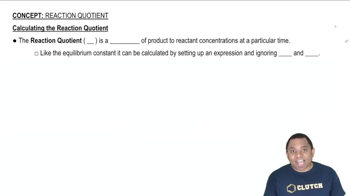The equilibrium constant constant 𝐾𝑐 for C(𝑠) + CO2(𝑔) ⇌ 2 CO(𝑔) is 1.9 at 1000 K and 0.133 at 298 K. (a) If excess C is allowed to react with 25.0 g of CO2 in a 3.00-L vessel at 1000 K, how many grams of CO are produced? (b) If excess C is allowed to react with 25.0 g of CO2 in a 3.00-L vessel at 1000 K, how many grams of C are consumed?
Ch.15 - Chemical Equilibrium
Chapter 15, Problem 88
What does this anecdote tell us about the equilibrium constant for the reaction of iron oxide with carbon monoxide to produce elemental iron and CO2?
 Verified step by step guidance
Verified step by step guidance1
Step 1: Identify the chemical reaction involved. The reaction of iron oxide (Fe2O3) with carbon monoxide (CO) to produce elemental iron (Fe) and carbon dioxide (CO2) can be represented as: Fe2O3(s) + 3CO(g) ⇌ 2Fe(s) + 3CO2(g).
Step 2: Understand the concept of the equilibrium constant (K). The equilibrium constant is a measure of the extent to which a reaction proceeds to form products at equilibrium. It is calculated using the concentrations of the reactants and products at equilibrium.
Step 3: Write the expression for the equilibrium constant (K) for the given reaction. For the reaction Fe2O3(s) + 3CO(g) ⇌ 2Fe(s) + 3CO2(g), the equilibrium constant expression is K = [CO2]^3 / [CO]^3. Note that solids are not included in the equilibrium expression.
Step 4: Analyze the anecdote for any information about the reaction conditions or the relative amounts of reactants and products. This can provide insight into whether the reaction favors the formation of products or reactants at equilibrium.
Step 5: Consider the implications of the equilibrium constant value. A large K value indicates that the reaction favors the formation of products, while a small K value suggests that the reaction favors the reactants.
Key Concepts
Here are the essential concepts you must grasp in order to answer the question correctly.
Equilibrium Constant (K)
The equilibrium constant (K) is a numerical value that expresses the ratio of the concentrations of products to reactants at equilibrium for a given chemical reaction. It provides insight into the extent to which a reaction proceeds; a large K indicates a reaction favoring products, while a small K suggests reactants are favored. Understanding K is crucial for analyzing how changes in conditions affect the position of equilibrium.
Recommended video:
Guided course

Equilibrium Constant K
Le Chatelier's Principle
Le Chatelier's Principle states that if a dynamic equilibrium is disturbed by changing the conditions, the system will adjust to counteract the change and restore a new equilibrium. This principle helps predict how changes in concentration, temperature, or pressure will affect the position of equilibrium in reactions, such as the one involving iron oxide and carbon monoxide.
Recommended video:
Guided course

Le Chatelier's Principle
Reaction Quotient (Q)
The reaction quotient (Q) is a measure of the relative concentrations of products and reactants at any point in time, not just at equilibrium. By comparing Q to the equilibrium constant K, one can determine the direction in which a reaction will proceed to reach equilibrium. If Q < K, the reaction will shift towards products; if Q > K, it will shift towards reactants.
Recommended video:
Guided course

Reaction Quotient Q
Related Practice
Textbook Question
1
views
Textbook Question
At 700 K, the equilibrium constant for the reaction CCl4(𝑔) ⇌ C(𝑠) + 2 Cl2(𝑔) is 𝐾𝑝 = 0.76. A flask is charged with 2.00 atm of CCl4, which then reaches equilibrium at 700 K. (a) What fraction of the CCl4 is converted into C and Cl2?
Textbook Question
At 700 K, the equilibrium constant for the reaction CCl4(𝑔) ⇌ C(𝑠) + 2 Cl2(𝑔) is 𝐾𝑝 = 0.76. A flask is charged with 2.00 atm of CCl4, which then reaches equilibrium at 700 K. (b) What are the partial pressures of CCl4 and Cl2 at equilibrium?
1
views
